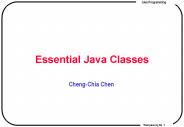Classes, Encapsulation, Methods and Constructors - PowerPoint PPT Presentation
Title:
Classes, Encapsulation, Methods and Constructors
Description:
A constructor is a special method that is used to set up an object when ... Every time a new Die object is created, a new faceValue variable is created as well ... – PowerPoint PPT presentation
Number of Views:32
Avg rating:3.0/5.0
Title: Classes, Encapsulation, Methods and Constructors
1
Classes, Encapsulation, Methods and Constructors
- Constructors
- Data Scope
- Instance data
- This reference
- Encapsulation and Java modifiers
- Reading for this Lecture LL, 4.1-4.4
2
Constructors
- A constructor is a special method that is used to
set up an object when it is initially created - A constructor has the same name as the class with
no return type - The Die constructor is used to set the initial
face value of each new die object to one - We examine constructors in more detail later
3
Data Scope
- The scope of data is the area in a program in
which that data can be referenced (used) - Data declared at the class level can be
referenced by all methods in that class - Data declared within a method can be used only in
that method - Data declared within a method is called local
data - In the Die class, the variable result is declared
inside the toString method -- it is local to that
method and cannot be referenced anywhere else
4
Instance Data
- The faceValue variable in the Die class is called
instance data because each instance (object) that
is created has its own version of it - A class declares the type of the data, but it
does not reserve any memory space for it - Every time a new Die object is created, a new
faceValue variable is created as well - The objects of a class share the code in the
method definitions, but each object has its own
data space - This is the way multiple objects created from the
same class can have different states
5
Instance Data
- We can depict the two Die objects from the
RollingDice program as follows
Each object maintains its own faceValue variable,
and thus its own state
6
The this Reference
- The this reference allows an object to refer to
itself - That is, the this reference, used inside a
method, refers to the object through which the
method is being executed - Suppose the this reference is used in a method
called tryMe, which is invoked as follows - In the first invocation, the this reference
refers to obj1 in the second it refers to obj2
obj1.tryMe() obj2.tryMe()
7
The this reference
- The this reference can be used to distinguish the
instance variables of a class from method
parameters with the same names - The constructor of the Account class could have
been written as follows
public Account (Sring name, long acctNumber,
double balance) this.name
name this.acctNumber acctNumber
this.balance balance
8
Encapsulation
- We can take one of two views of an object
- internal - the details of the variables and
methods of the class that defines it - external - the services that an object provides
and how the object interacts with the rest of the
system - From the external viewpoint, an object is an
encapsulated entity providing a set of specific
services - These services define the interface to the object
9
Encapsulation
- One object (called the client) may use another
object for the services it provides - The client of an object may request its services
(call its methods), but it should not have to be
aware of how those services are accomplished - Any changes to the object's state (its variables)
should be made by that object's methods - We should make it difficult, if not impossible,
for a client to access an objects variables
directly - That is, an object should be self-governing
10
Encapsulation
- An object can be thought of as a black box -- its
inner workings are encapsulated or hidden from
the client - The client invokes the interface methods of the
object, which manages the instance data
11
Visibility Modifiers
- In Java, we accomplish encapsulation through the
appropriate use of visibility modifiers - A modifier is a Java reserved word that specifies
particular characteristics of a method or data - We've used the final modifier to define constants
- Java has three visibility modifiers public,
protected, and private - The protected modifier involves inheritance,
which we will discuss later
12
Visibility Modifiers
- Members of a class that are declared with public
visibility can be referenced anywhere - Members of a class that are declared with private
visibility can be referenced only within that
class - Members declared without a visibility modifier
have default visibility and can be referenced by
any class in the same package
13
Visibility Modifiers
- Public variables violate the spirit of
encapsulation because they allow the client to
reach in and modify the objects internal
values directly - Therefore, instance variables should not be
declared with public visibility - It is acceptable to give a constant public
visibility, which allows it to be used outside of
the class - Public constants do not violate encapsulation
because, although the client can access it, its
value cannot be changed
14
Visibility Modifiers
- Methods that provide the object's services are
declared with public visibility so that they can
be invoked by clients - Public methods are also called service methods
- A method created simply to assist a service
method is called a support method - Since a support method is not intended to be
called by a client, it should be declared with
private - not with public visibility
15
Visibility Modifiers - Summary
Enforce encapsulation
Violate encapsulation
Support other methods in the class
Provide services to clients































